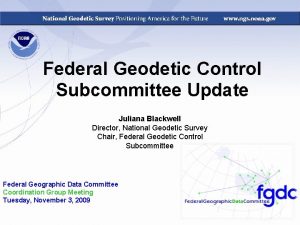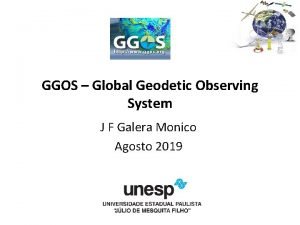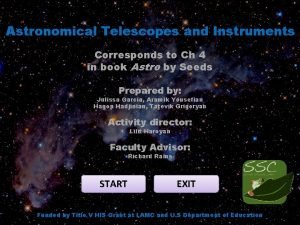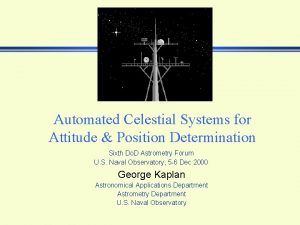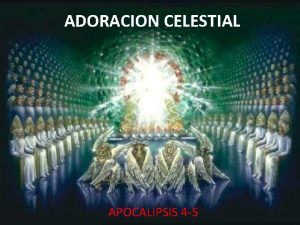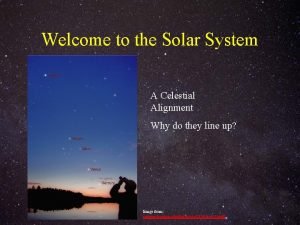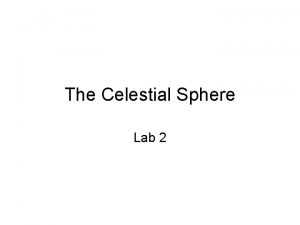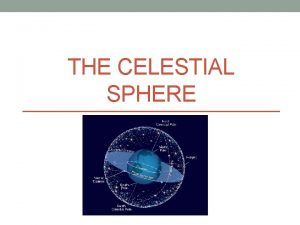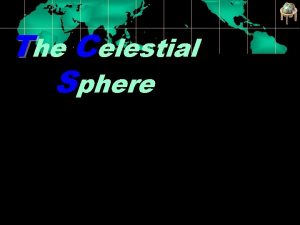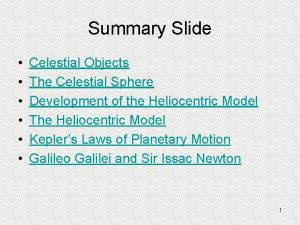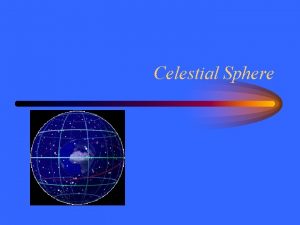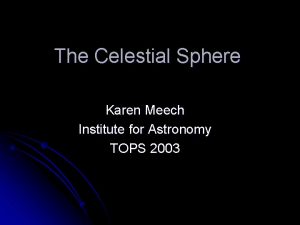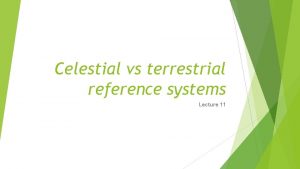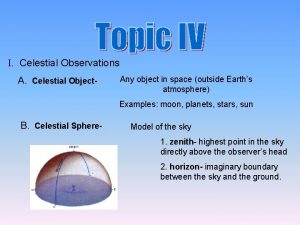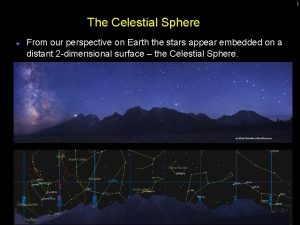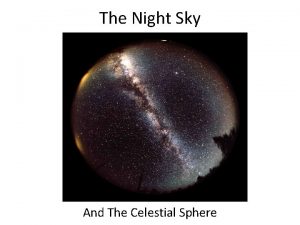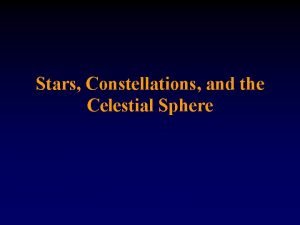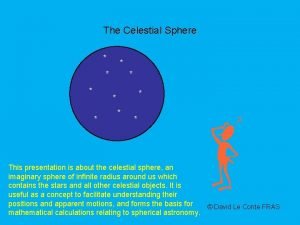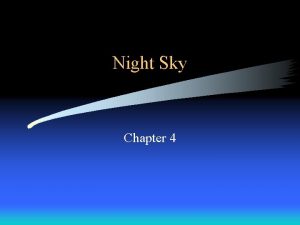Geodetic astronomy Lecture 06 Geodetic astronomy Celestial sphere




































- Slides: 36

Geodetic astronomy Lecture 06

Geodetic astronomy Celestial sphere Celestial coordinates (of a celestial body) Horizon coordinate system Equatorial coordinate system Ecliptic coordinate system Concepts of time Sidereal time, solar time, atomic time/UTC/GPST Astronomical positioning

Celestial sphere Elements on the sphere zenith, horizon celestial North pole, celestial equator local meridian zenith and meridian at Greenwich astronomical latitude and longitude apparent motion The Sun and the ecliptic, obliquity Sun’s apparent motion Vernal vs Autumn equinox polar circle

Introduction Celestial coordinate systems are used to define the coordinates of celestial bodies such as stars. The distance from the earth to the nearest star is more than 109 earth radii, therefore, the dimensions of the earth are almost negligible compared to the distances to the stars. A second consequence of these great distances is that, although the stars themselves are believed to be moving at velocities near the velocity of light, to an observer on the earth this motion is perceived to be very small, very rarely exceeding one arcsecond per year. Relatonship between the earth and stars can be closely approximated by considering the stars all to be equidistant from the earth, on the surface of the celestial sphere, the dimension of which is so large that the earth can be considered as a dimensionless point at the center. Although this point may be dimensionless, relationships between directions on the earth and in the solar system can be extended to the celestial sphere.

Introduction The earth's rotation axis is extended outward to intersect the celestial sphere at the north celestial pole (NCP) and south celestial pole (SCP). The earth's equatorial plane extended outward intersects the celestial sphere at the celestial equator. The gravity vertical at a station on the earth is extended upwards to intersect the celestial sphere at the zenith (Z), and downwards to intersect at the nadir (N). The plane of the earth's orbit around the sun (the ecliptic plane) is extended outward to intersect the celestial sphere at the ecliptic. The line of intersection between the earth's equatorial plane and the ecliptic plane is extended outwards to intersect the celestial sphere at the vernal equinox or first point of Aries, and the autumnal equinox. The vernal equinox is denoted by the symbol , and is the point at which the sun crosses the celestial equator from south to north.

Introduction There are two fundamental differences between celestial systems and terrestrial or orbital systems. First, only directions and not distances are considered in celestial coordinate systems. In effect this means that the celestial sphere can be considered the unit sphere, and all vectors dealt with are unit vectors. The second difference is related to the first, in that the celestial geometry is spherical rather than ellipsoidal as in terrestrial and orbital systems, which simplifies the mathematical relationships involved. There are four main celestial coordinate systems, called the ecliptic, right ascension, hour angle, and horizon. Sometimes the right ascension and hour angle systems are referred to collectively as equatorial systems.

Celestial sphere

Celestial sphere – the ecliptic

Polar circle

Celestial coordinates of celestial bodies

Horizon coordinates A and z (or h) Azimuth: A Zenith distance: Height angle: h z


Equatorial coordinate – hour angle

Ecliptic coordinates and

Astronomical triangle What are the sides and angles ? Which quantity changes with time due to apparent motion ?

Spherical trigonometry

Trigonometric formulas for the astronomical triangle

Concepts of time

Definition of Sidereal time

Sidereal time

Time, Longitude, and Right Ascension

Definition of True Solar time

Non-uniform motion of the Earth

Definition of Mean Solar time

Universal Time (UT)

Zone time (mean solar time) Zone time: mean solar time referred to the mid-meridian of a zone with longitude difference of 15 degrees Ethiopian time: ET = GMT + 3 h

Julian date

Greenwich Mean Sidereal Time (GMST)0 at mid-night (UT 1=0)

Conversion from Mean Solar Time UT 1 to Greenwich Mean Sidereal Time GAST

Universal Time Coordinated (UTC)

Variation of UT 1 -UTC

Variation of UT 1 -UTC

Astronomical Positioning

Azimuth determination with Polaris

Latitude determination

Simultaneous determination of (Φ, Λ)
 Local hour angle
Local hour angle Sphere of influence vs sphere of control
Sphere of influence vs sphere of control Learning astronomy by doing astronomy activity 7 answers
Learning astronomy by doing astronomy activity 7 answers Learning astronomy by doing astronomy activity 1 answers
Learning astronomy by doing astronomy activity 1 answers Learning astronomy by doing astronomy
Learning astronomy by doing astronomy 01:640:244 lecture notes - lecture 15: plat, idah, farad
01:640:244 lecture notes - lecture 15: plat, idah, farad Ngs cors
Ngs cors State geodetic administration
State geodetic administration Datum
Datum Federal geodetic control subcommittee
Federal geodetic control subcommittee Ngs geodetic toolkit
Ngs geodetic toolkit Federal geodetic control subcommittee
Federal geodetic control subcommittee Pengertian teropong pendatar tangan
Pengertian teropong pendatar tangan Federal geodetic control subcommittee
Federal geodetic control subcommittee Geodetic
Geodetic Ggos
Ggos Padre celestial al entrar en mi lugar de trabajo
Padre celestial al entrar en mi lugar de trabajo Padre celestial al entrar en mi lugar de trabajo
Padre celestial al entrar en mi lugar de trabajo Celestial objects
Celestial objects Celestial bodies context clues
Celestial bodies context clues Padre celestial al entrar en mi lugar de trabajo
Padre celestial al entrar en mi lugar de trabajo Sede perfeitos como vosso pai
Sede perfeitos como vosso pai Deus nosso pai celestial
Deus nosso pai celestial Trisagio celestial
Trisagio celestial Sr 71 star tracker
Sr 71 star tracker Celestial nocchiero
Celestial nocchiero Padre celestial al entrar en mi lugar de trabajo
Padre celestial al entrar en mi lugar de trabajo Sees the celestial
Sees the celestial Apoc 4
Apoc 4 Biografia de tristan tzara
Biografia de tristan tzara Querido padre celestial
Querido padre celestial Perpendicular lines in haircutting
Perpendicular lines in haircutting Phaethon
Phaethon Cantos de apocalipsis
Cantos de apocalipsis Padre celestial al entrar en mi lugar de trabajo
Padre celestial al entrar en mi lugar de trabajo Quoar
Quoar Centered celestial object
Centered celestial object









